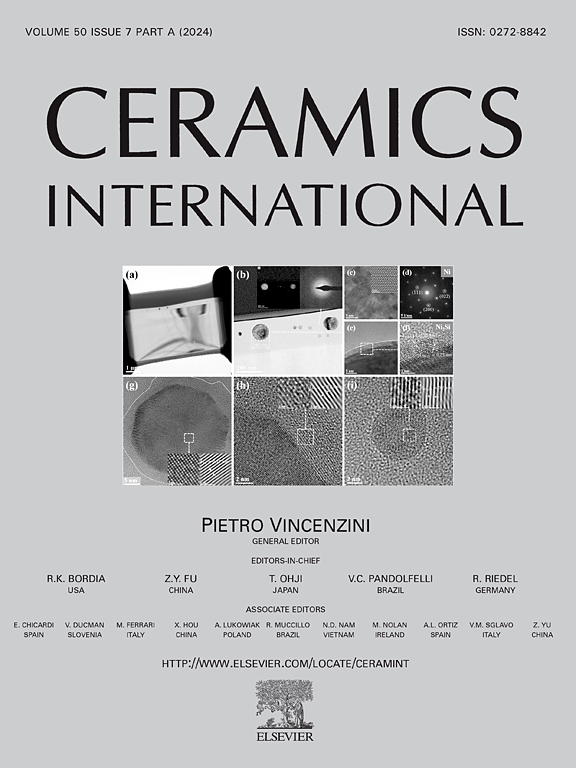新型铁基复合材料Al-Fe3O4铸造功能粉的制备及性能研究
IF 5.6
2区 材料科学
Q1 MATERIALS SCIENCE, CERAMICS
引用次数: 0
摘要
铸渗法是一种广泛应用的金属基复合材料制备技术。Al-Fe3O4粉末已成为一种新型的铸造功能材料。本研究着重探讨了反应的特点、机理以及工艺参数对放热性能的影响。值得注意的是,反应产物受到不同大气条件的显著影响。Al-Fe3O4铸造功能粉在从20℃加热到1300℃的过程中经历了6个温度节点。通过对粉体参数的精确控制,可以在较宽的范围内(600℃- 900℃)调节反应温度,而放热输出可以在200 ~ 1300 J/g之间调节。Al-Fe3O4铸造功能粉末通过其放热反应,在释放大量热量的同时产生Fe和Al2O3,从而实现创新的铸造应用。这种释放的热量有效地提高了ZTA和衬底界面的温度,从而促进了冶金键合,形成了优化的柔性界面层,显著提高了复合材料的整体性能。本文章由计算机程序翻译,如有差异,请以英文原文为准。
Preparation and properties of Al-Fe3O4 casting functional powder of novel iron-based composite
The cast-penetration process is a widely utilized technique for fabricating metal matrix composites. Al-Fe3O4 powder has emerged as a novel functional material for casting applications. This study focuses on investigating the reaction characteristics, underlying mechanisms, and the influence of process parameters on exothermic properties. Notably, the reaction products are significantly affected by varying atmospheric conditions. The Al-Fe3O4 casting functional powder undergoes six temperature nodes during the heating process from 20 °C to 1300 °C. By precisely controlling the powder parameters, the reaction temperature can be adjusted within a broad range (600 °C–900 °C), while the exothermic energy output can be regulated between 200 J/g and 1300 J/g. Al-Fe3O4 casting functional powder enables innovative casting applications through its exothermic reaction, which generates Fe and Al2O3 while releasing significant heat. This released heat effectively elevates the temperature at the ZTA and substrate interfaces, thereby promoting metallurgical bonding and forming an optimized flexible interface layer that significantly enhances the overall performance of the composite material.
求助全文
通过发布文献求助,成功后即可免费获取论文全文。
去求助
来源期刊

Ceramics International
工程技术-材料科学:硅酸盐
CiteScore
9.40
自引率
15.40%
发文量
4558
审稿时长
25 days
期刊介绍:
Ceramics International covers the science of advanced ceramic materials. The journal encourages contributions that demonstrate how an understanding of the basic chemical and physical phenomena may direct materials design and stimulate ideas for new or improved processing techniques, in order to obtain materials with desired structural features and properties.
Ceramics International covers oxide and non-oxide ceramics, functional glasses, glass ceramics, amorphous inorganic non-metallic materials (and their combinations with metal and organic materials), in the form of particulates, dense or porous bodies, thin/thick films and laminated, graded and composite structures. Process related topics such as ceramic-ceramic joints or joining ceramics with dissimilar materials, as well as surface finishing and conditioning are also covered. Besides traditional processing techniques, manufacturing routes of interest include innovative procedures benefiting from externally applied stresses, electromagnetic fields and energetic beams, as well as top-down and self-assembly nanotechnology approaches. In addition, the journal welcomes submissions on bio-inspired and bio-enabled materials designs, experimentally validated multi scale modelling and simulation for materials design, and the use of the most advanced chemical and physical characterization techniques of structure, properties and behaviour.
Technologically relevant low-dimensional systems are a particular focus of Ceramics International. These include 0, 1 and 2-D nanomaterials (also covering CNTs, graphene and related materials, and diamond-like carbons), their nanocomposites, as well as nano-hybrids and hierarchical multifunctional nanostructures that might integrate molecular, biological and electronic components.
 求助内容:
求助内容: 应助结果提醒方式:
应助结果提醒方式:


